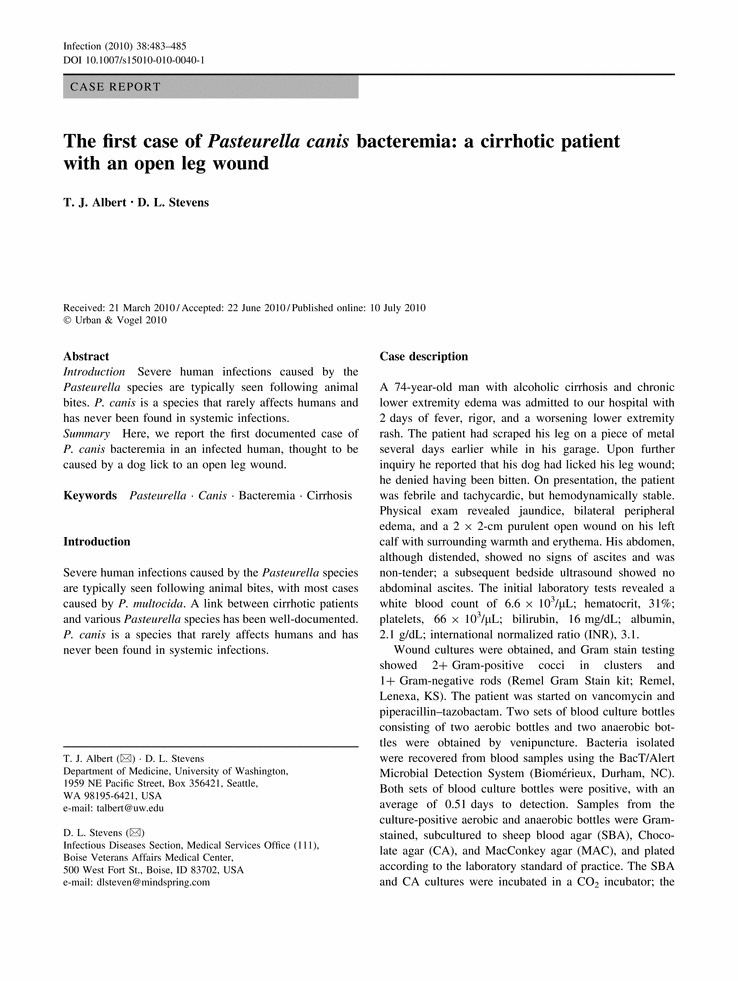Order Pasteurellales | Phylum Proteobacteria Rank Species | |
 | ||
Similar Pasteurella, Pasteurellaceae, Capnocytophaga canimorsus, Eikenella corrodens, Corynebacterium jeikeium | ||
Pasteurella canis is a Gram-negative, nonmotile, penicillin-sensitive coccobacillus belonging to the Pasteurellaceae family. Bacteria from this family cause zoonotic infections in humans, which manifest themselves as skin or soft-tissue infections after an animal bite. It has been known to cause serious disease in immunocompromised patients.
Contents
- Nomenclature
- Microbiology
- Molecular typing
- Disease
- Animal infections
- Human infections
- Antibiotics treatment and resistance
- References
Pasteurella was first described around 1880 and thought to be associated with chicken cholera and hemorrhagic septicemia in animals. The genus was first cultured in 1885. In 1920, strains of Pasteurella were isolated and observed in human infections.
Nomenclature
“Micrococcus gallicidus” was the first scientific name used for these bacteria. For a short time, the bacteria were unofficially placed in different genera, such as Octopsis, Coccobacillus, and Eucystia. In 1887, genus “Pasteurella” was proposed to honor Louis Pasteur for his critical discoveries in the field of microbiology.
Before molecular technology was available, species were often labeled based on staining and the hosts from where species were isolated. The name "multocida" was ultimately adopted to represent all the Pasteurella species. Until 1932, the genus Pasteurella only consisted of the species type Pasteurella multocida. Pasteurella canis sp. nov. was previously classified as P. multocida biotype 6 or “dog-type” strains. In 1985, Pasteurella underwent taxonomic reclassification based on DNA hybridization, resulting in several subspecies of P. multocida and new Pasteurella species, including P. canis.
P. canis includes two biotypes: biovar 1 originated from canines, whereas biovar 2 originated from bovines. The two biotypes are distinguishable from an indole test: biovar 1 is indole positive whereas biovar 2 is indole negative.
Microbiology
P. canis is a Gram-negative coccobacillus that shows bipolar staining. P. canis forms small, grey-colored, round, and smooth colonies. It is also nonhaemolytic and nonmotile.
P. canis is reported as aerobic and facultative anaerobic in different sources. It metabolizes both glucose and sucrose. In addition to morphological typing, biochemical tests are commonly used to identify the species. P. canis is positive for catalase, oxidase, and ornithine decarboxylase, but negative for lysine decarboxylase, V-factor (nicotinamide adenine dinucleotide), D-mannitol, dulcitol, D-sorbitol, urease, maltose, and L-arabinose. It can also be indole positive or negative depending on the biotype.
Molecular typing
Molecular analysis of the genome has become the popular method to identify bacteria. The genome of P. canis has yet to be fully sequenced, but several genes and their sequences were already identified. Among them, 16S rRNA, 23S rRNA, RNA polymerase subunit B (rpoB), and manganese-dependent superoxide dismutase (sodA) are used to study Pasteurella phylogeny. However, molecular and biochemical analyses often show conflicting results. For example, research has suggested some P. canis strains were in fact members of P. multocida based on DNA analysis. Phylogenetic analysis of P. canis and P. dagmatis also showed conflicting results, based on their 16s rRNA sequences and biochemical tests done on the strains.
Disease
P. canis is an opportunistic pathogen that can infect both animals and humans.
Animal infections
P. canis can be found in healthy domesticated, farm-raised, and wild animals, such as dogs, cats, rabbits, horses, sheep, cattle, ferrets, deer, and even California sea lions. The bacteria are normally isolated from the oral cavities and respiratory tracts of these animals. P. canis biotype 1 was shown to secrete a toxin analogous to P. multocida toxin, but its identity is unknown. P. canis is responsible for a number of canine infections, including systemic infection, external otitis, bacterial rhinitis, vertebral osteomyelitis, meningomyelitis (a type of myelitis), bronchopneumonia, tracheitis, paranasal sinus inflammation, and toxicosis. Horses infected with the bacteria may develop arthritis. The bacteria also cause pneumonia in cattle and various infections in sheep, cats, rabbits, and deer.
Human infections
P. canis is mainly transmitted from animals to humans through animal bites, scratches, or licking over wounds. However, some patients developed infections without any scratches and puncture wounds. In one case, a patient exposed to rabbit secretions was infected with P. canis. Those with rheumatoid arthritis, cirrhosis, and diabetes mellitus are more susceptible to the bacteria. Patients who are immunocompromised also have higher risk of infections.
P. canis often causes soft-tissue infections and wound infections, as well as systemic bacteremia in humans. These infections include peritonitis, conjunctivitis, osteomyelitis, and arthritis. Joint prosthetics can also be infected by the bacteria.
Antibiotics treatment and resistance
Many common antibiotics can successfully treat P. canis infections in both humans and animals. P. canis has shown sensitivity to ampicillin (penicillin), cefuroxime (second-generation cephalosporin), most third-generation cephalosporins (cefixime, cefotaxime, ceftriaxone, and cefoperazone), ciprofloxacin (quinolones), trimethoprim/sulfamethoxazole (sulfonamides), chloramphenicol, most aminoglycosides, and tetracycline. However, the bacterium is also resistant to numerous drugs, such as dicloxacillin (penicillin), some aminoglycosides (spectinomycin and neomycin), vancomycin (glycopeptides), cephalexin and cefadoxil (first-generation cephalosporin), erythromycin (macrolides), and imipenem (carbapenem).
